Family name: Ulmaceae Mirbel
Synonym(s): none
Common name(s): elm family
*Number of genera/species: 7/45
List of genera records in GRIN-Global
Fruit a samarasamara:
a winged, indehiscent, dry fruit containing a single (rarely two) seed(s) or drupedrupe:
or drupedrupe:
(indehiscent drupe) a fleshy, indehiscent fruit with one more hard pits enclosing seeds, derived from single, superior, simple or compound ovary; (dehiscent drupe) a fruit with a dry or fibrous to fleshy or leathery outer husk that early to tardily breaks apart (or opens), exposing one or more nutlike pits enclosing the seeds (Ampelocera, Planera (dry)), 2.5–40 mm long, globoseglobose:
(Ampelocera, Planera (dry)), 2.5–40 mm long, globoseglobose:
3D shape—more or less spherical or roundround:
or roundround:
2D shape—orbiculate; circular in compressedcompressed:
in compressedcompressed:
flattened; in grasses, used to denote compression (not necessarily flattened) either laterally or dorsiventrally
fruits, ellipsoidellipsoid:
3D shape—elliptic
, ovoidovoid:
3D shape—ovate , often asymmetrical, usually compressedcompressed:
, often asymmetrical, usually compressedcompressed:
flattened; in grasses, used to denote compression (not necessarily flattened) either laterally or dorsiventrally
in transection, rarely tereteterete:
approximately circular in cross section; width and thickness approximately equal
 , stigmasstigma:
, stigmasstigma:
the portion of the pistil receptive to pollen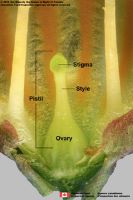 often persistent forming a short to moderate beakbeak:
often persistent forming a short to moderate beakbeak:
a usually firm, terminal appendage, sometimes tapered , usually winged, if winged with two broad wings, winged on one side, or wing encompassing seed, with one seed, sometimes enclosed by persistent perianthperianth:
, usually winged, if winged with two broad wings, winged on one side, or wing encompassing seed, with one seed, sometimes enclosed by persistent perianthperianth:
collective term for calyx and corolla of a flower
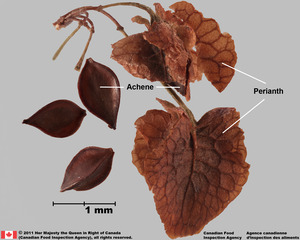 . Pericarppericarp:
. Pericarppericarp:
fruit wall or fruit coat
brown, green, reddish, orange, or yellow, dulldull:
reflecting only a low proportion of incident light, with no apparent sheen , usually dry, rarely leatheryleathery:
, usually dry, rarely leatheryleathery:
texture—moderately thick, tough, and very pliable
(Planera), glabrousglabrous:
without hairs
or pubescentpubescent:
surface relief—bearing hairs
with short, white hairs, usually smooth, rarely thick ribbedribbed:
surface relief—wide, prominent, linear ridges that are generally rounded and longitudinally situated on the surface with wartywarty:
with wartywarty:
surface relief—distinct, rounded projections that are large relative to the fruit size; tuberculate, verrucose projections (Planera).
projections (Planera).
Seeds globoseglobose:
3D shape—more or less spherical , ovateovate:
, ovateovate:
2D shape—egg-shaped in outline, widest point is towards one end of the organ, the other end tapers gradually, attachment at or near the broad end (compare obovate, ovoid) , or pear-shaped, compressedcompressed:
, or pear-shaped, compressedcompressed:
flattened; in grasses, used to denote compression (not necessarily flattened) either laterally or dorsiventrally
in transection, 5–15 mm long. Seed coat brown, membranousmembranous:
texture—extremely thin, pliable, and fairly tough
, marginalmarginal:
at, on, or close to the margin or border
tissue wing-like, glabrousglabrous:
without hairs
, striatestriate:
surface relief—having fine, parallel lines, grooves or ridges , or reticulatereticulate:
, or reticulatereticulate:
surface relief—netted, raised walls or concave grooves forming a net-like surface pattern with flat, concave, or convex interspaces . Hila oblong or ellipsoidellipsoid:
. Hila oblong or ellipsoidellipsoid:
3D shape—elliptic
.
Embryo well developed, completely or nearly completely filling seed coat, linearlinear:
(shape) long, narrow, and uniform in width; (of embryo) embryo is straight and much longer than wide or foliatefoliate:
or foliatefoliate:
appearing leaf-like
, usually straight curvedcurved:
(of embryo) linear embryo is curved into an arch or horseshoe with the ends far apart ) Zelkova).
) Zelkova).
Endosperm scanty or absent.
| Fruit | |
| Type | samara, drupe |
| Size range | 2.5–40 mm long |
| Shape(s) | globose, roundround: 2D shape—orbiculate; circular  in compressedcompressed: in compressedcompressed:flattened; in grasses, used to denote compression (not necessarily flattened) either laterally or dorsiventrally fruits, ellipsoidellipsoid: 3D shape—elliptic , ovoidovoid: 3D shape—ovate  , often asymmetrical , often asymmetrical |
| Surface relief | smooth, ribbedribbed: surface relief—wide, prominent, linear ridges that are generally rounded and longitudinally situated on the surface 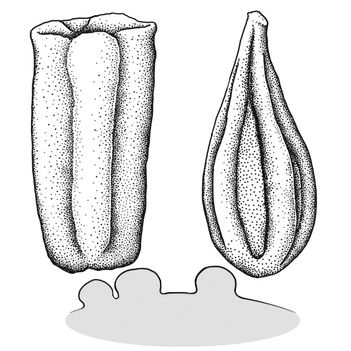 with wartywarty: with wartywarty:surface relief—distinct, rounded projections that are large relative to the fruit size; tuberculate, verrucose 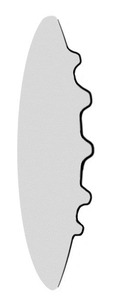 projections projections |
| Color(s) | brown, green, reddish, orange, yellow |
| Unique features | Usually brown, winged, compressedcompressed: flattened; in grasses, used to denote compression (not necessarily flattened) either laterally or dorsiventrally samaras with striatestriate: surface relief—having fine, parallel lines, grooves or ridges  or reticulatereticulate: or reticulatereticulate:surface relief—netted, raised walls or concave grooves forming a net-like surface pattern with flat, concave, or convex interspaces  , flattened seeds. , flattened seeds. |
| Seed | |
| Size range | 5–15 mm long |
| Shape(s) | globose, ovateovate: 2D shape—egg-shaped in outline, widest point is towards one end of the organ, the other end tapers gradually, attachment at or near the broad end (compare obovate, ovoid)  , pyriform , pyriform |
| Surface relief | striate, reticulate |
| Color(s) | brown |
| Unique features | Flattened, striatestriate: surface relief—having fine, parallel lines, grooves or ridges  or reticulatereticulate: or reticulatereticulate:surface relief—netted, raised walls or concave grooves forming a net-like surface pattern with flat, concave, or convex interspaces  seeds with well-developed embryos completely or nearly filling seed coat. seeds with well-developed embryos completely or nearly filling seed coat. |
| Other | |
| Embryo | well developed, completely or nearly completely filling seed coat, linearlinear: (shape) long, narrow, and uniform in width; (of embryo) embryo is straight and much longer than wide 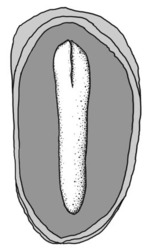 or foliatefoliate: or foliatefoliate:appearing leaf-like , usually straight (curved, Zelkova) |
| Nutritive tissuenutritive tissue: tissue within the seeds that nourishes the developing embryo; such as endosperm, perisperm, or chalazosperm in angiosperms; megagametophyte in gymnosperms |
endosperm endosperm: nutritive starch- and oil-containing tissue present in many seeds 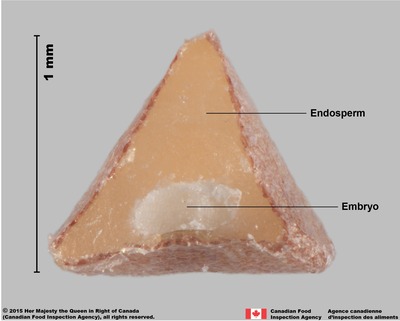 scanty or absent scanty or absent |
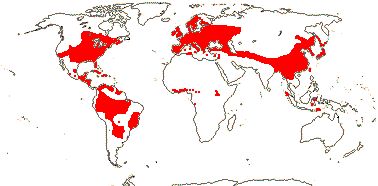
Distribution map courtesy of Angiosperm Phylogeny Website.
Flora of North America Editorial Committee 1993+Flora of North America Editorial Committee 1993+:
Flora of North America Editorial Committee, eds. 1993+. Flora of North America North of Mexico [Online]. 22+ vols. Flora of North America Association, New York and Oxford. Accessed January-March 2024. URL: http://beta.floranorthamerica.org.; Fragnière et al. 2021Fragnière et al. 2021:
Fragnière Y, Song Y-G, Fazan L, Manchester S, Garfì G, and Kozlowski G. 2021. Biogeographic overview of Ulmaceae: Diversity, distribution, ecological preferences, and conservation status. Plants 10. https://doi.org/10.3390/plants10061111.; Kirkbride et al. 2006Kirkbride et al. 2006:
Kirkbride JH, Jr, Gunn CR, and Dallwitz MJ. 2006. Family guide for fruits and seeds, vers. 1.0. Accessed September 2020-January 2022. URL: https://nt.ars-grin.gov/seedsfruits/keys/frsdfam/index.cfm .; Kubitzki et al. 1990+Kubitzki et al. 1990+:
Kubitzki K et al., eds. 1990+. The families and genera of vascular plants. 7+ vols. Berlin etc.; Nee 2023Nee 2023:
Nee M. 2023. Ulmaceae—Flora Mesoamericana. Accessed April 2023. URL: http://legacy.tropicos.org/Project/FM.; Pederneiras and Machado 2017Pederneiras and Machado 2017:
Pederneiras LC and Machado AFP. 2017. Flora do estado do Rio de Janeiro: Ulmaceae. Rodriguésia 68: 541&-543.; Takhtajan 2009Takhtajan 2009:
Takhtajan A. 2009. Flowering plants: Second edition. Springer Nature, Switzerland. 871 pp.; Todzia 1989Todzia 1989:
Todzia CA. 1989. A Revision of Ampelocera (Ulmaceae). Annals of the Missouri Botanical Garden 76(4): 1087&-1102. https://doi.org/10.2307/2399693; Todzia 1992Todzia 1992:
Todzia CA. 1992. A reevaluation of the genus Phyllostylon (Ulmaceae). SIDA, Contributions to Botany 15: 263&-270.; Todzia and Panero 1998Todzia and Panero 1998:
Todzia CA and Panero JL. 1998. A new species of Ulmus (Ulmaceae) from southern Mexico and a synopsis of the species in Mexico. Brittonia 50(3): 343&-347.; Tropicos.org 2021+Tropicos.org 2021+:
Tropicos.org. 2021+. Pakistan Plant Database. Missouri Botanical Garden. Accessed January 2021–April 2024. http://legacy.tropicos.org/Project/Pakistan; Tutin et al. 1964Tutin et al. 1964:
Tutin TG, Burges NA, Chater AO, Edmondson JR, Heywood VH, Moore DM, Valentine DH, Walters SM, and Webb DA, eds. 1964. Flora Europaea. Cambridge, University Press.; Zhengyi et al. 2004+Zhengyi et al. 2004+:
Zhengyi W, Raven PH, and Deyuan H. 2004+. Flora of China [online]. 25 vols. Science Press, Beijing China & Missouri Botanical Garden, St. Louis USA. Accessed January–March 2024. http://flora.huh.harvard.edu/china/
*The number of genera and species is based on Christenhusz and Byng 2016Christenhusz and Byng 2016:
Christenhusz MJM and Byng JW. 2016. The number of known plant species in the world and its annual increase. Phytotaxa 261 (3): 201-217. https://doi.org/10.11646/phytotaxa.261.3.1, which may differ from the number of genera in GRIN-Global.